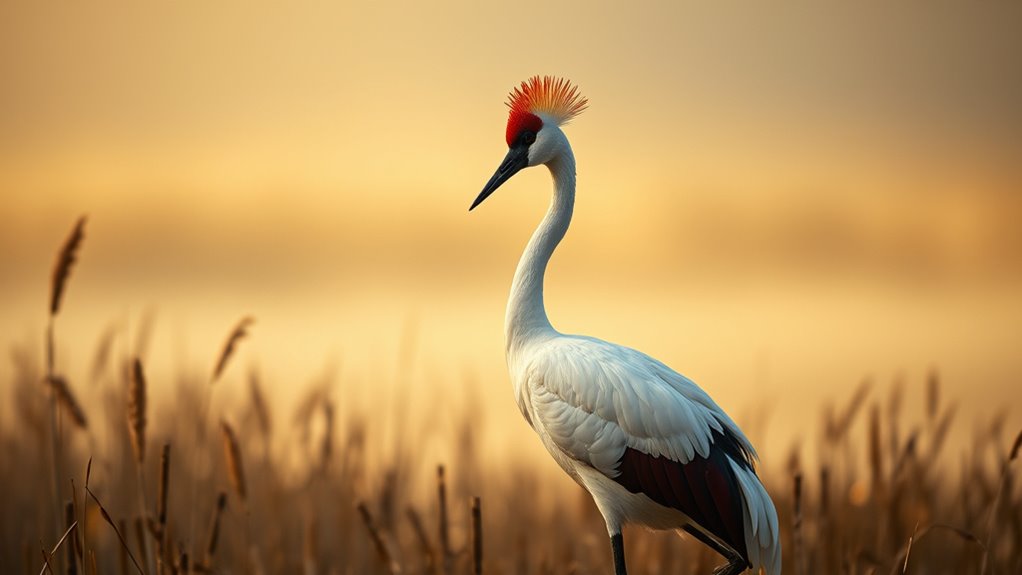The red-crowned crane, with its striking white plumage and vibrant red crown, embodies elegance and longevity in East Asia. It symbolizes fidelity and good fortune, appearing frequently in art and folklore. Revered in cultures like Japan and China, this magnificent bird represents peace and prosperity. Sadly, its population faces threats from habitat loss and climate change. By learning about its beauty and cultural significance, you can discover how conservation efforts aim to protect this iconic symbol.
Key Takeaways
- The Red-Crowned Crane is celebrated for its striking white plumage and red crown, symbolizing longevity and good fortune in East Asian cultures.
- It embodies grace and beauty, often representing peace and prosperity in art and folklore across Japan and China.
- Conservation challenges, including habitat loss and climate change, threaten the crane’s population, highlighting the need for ecological preservation.
- Community engagement and conservation efforts focus on restoring wetland habitats and raising awareness about the crane’s cultural and ecological significance.
- Protecting the Red-Crowned Crane fosters cultural traditions while emphasizing the interconnectedness of environmental health and sustainability.

Have you ever seen a Red-Crowned Crane in flight? If you have, you know it’s a breathtaking sight. These magnificent birds, with their striking white plumage and distinctive red crown, glide gracefully through the air, embodying elegance and beauty. Their presence isn’t just a visual delight; it holds deep cultural symbolism across East Asia. In countries like Japan and China, these cranes are revered as symbols of longevity, fidelity, and good fortune. You might even find them featured in art and folklore, representing peace and prosperity.
The Red-Crowned Crane, an emblem of beauty and cultural significance, symbolizes longevity and good fortune across East Asia.
However, the story of the Red-Crowned Crane isn’t just about admiration; it’s also about survival. Over the years, these birds have faced significant threats due to habitat loss, climate change, and human encroachment. You might be surprised to learn that their population has dwindled alarmingly in some areas, which is where conservation efforts come into play. Organizations and local communities are working tirelessly to protect their habitats and ensure these birds can thrive. You can support these initiatives by staying informed and advocating for policies aimed at preserving wetlands and natural habitats.
If you take a closer look at these conservation efforts, you’ll see that they often involve community engagement. Local people become stewards of their environment, understanding the importance of maintaining the delicate ecosystems that support the Red-Crowned Crane and other wildlife. By educating communities about the ecological significance of these cranes, conservationists are fostering a sense of pride and responsibility. You might even find opportunities to volunteer or participate in local awareness programs that aim to restore habitats or monitor crane populations.
As a symbol of resilience, the Red-Crowned Crane reminds us of our interconnectedness with nature. When you think about the cultural ties these birds have with East Asian communities, it’s clear that protecting them is more than just about saving a species; it’s about preserving traditions and values. Additionally, hydrogen can be produced from renewable sources, offering sustainable energy solutions that can help mitigate climate change impacts affecting their habitats. So, the next time you see a Red-Crowned Crane, take a moment to appreciate not only its beauty but also the cultural significance it holds.
Frequently Asked Questions
What Is the Lifespan of a Red-Crowned Crane in the Wild?
In the wild, a red-crowned crane typically lives around 20 to 30 years. You’ll find these cranes in wetlands, where they thrive in shallow water and tall grasses. Their breeding habits are fascinating; they often mate for life and perform elaborate courtship dances. By understanding their habitat preferences and breeding behaviors, you can appreciate how vital these environments are for their survival and longevity in the wild.
Are Red-Crowned Cranes Migratory Birds?
Yes, red-crowned cranes are migratory birds. They typically follow specific migration patterns, traveling between their breeding habitats and wintering grounds. In the spring, you’ll see them move to wetlands to breed, where they’ll establish strong pair bonds. When winter arrives, they migrate to milder regions to find food and shelter. Understanding their breeding habits and migration patterns is essential for conservation efforts, as these beautiful birds rely on both habitats for survival.
What Do Red-Crowned Cranes Eat?
Red-crowned cranes primarily eat a variety of foods, showcasing their dietary diversity. You’ll find them foraging for aquatic plants, insects, small fish, and crustaceans in wetlands and rice fields. Their feeding habits adapt to seasonal changes, allowing them to thrive in different environments. By understanding their diet, you can appreciate how these beautiful birds play a vital role in their ecosystem, balancing the food chain while enjoying their varied meals.
How Can I Help Conserve Red-Crowned Cranes?
You can help conserve red-crowned cranes by supporting habitat preservation efforts in their natural environments. Get involved with local organizations that focus on wetland restoration and protection. Additionally, participate in community education programs to raise awareness about the importance of these cranes and their ecosystems. By sharing information with friends and family, you’ll foster a greater appreciation for wildlife conservation, encouraging others to join in the effort to protect these majestic birds.
What Is the Cultural Significance of Red-Crowned Cranes in East Asia?
Red-crowned cranes hold deep cultural significance in East Asia, symbolizing longevity and fidelity. You’ll find them featured in traditional symbolism across various art forms, from paintings to poetry. Their elegant presence often represents peace and prosperity, making them a popular subject in artistic representations. By appreciating their role in cultural heritage, you can help promote awareness and conservation efforts, ensuring that these majestic birds continue to inspire future generations.
Conclusion
In the gentle embrace of East Asia, the red-crowned crane dances gracefully, symbolizing love and longevity. This majestic bird weaves its way into our hearts and cultures, reminding us of life’s delicate beauty. So, as you watch it soar through the skies, let yourself be swept away by the enchantment it brings. Embracing these elegant creatures is like cherishing a cherished memory, one that whispers tales of hope and harmony for generations to come.










